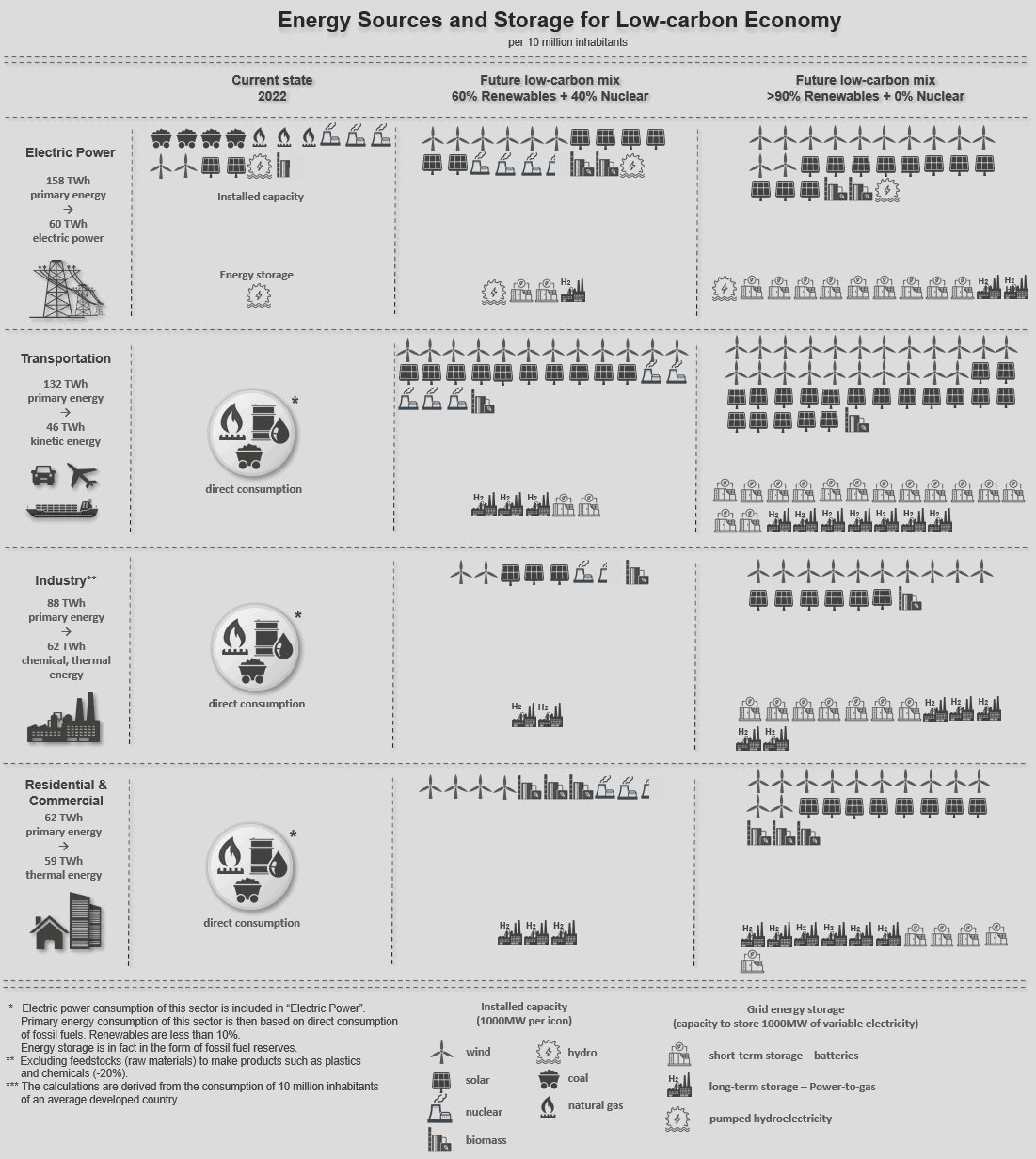This infographic describes two scenarios of the future low-emission economy and their estimated requirements for the installed capacity of energy sources and energy storage. All input data are derived from the consumption of 10 million inhabitants of an average developed country.
All assumptions are listed below. We welcome any discussion about these assumptions.

Low-carbon Economy – General assumptions
- The annual primary energy consumption is 440 TWh/10,000,000 inhabitants of an average developed country. Electric power consumption of transportation, industrial and residential sector included in Electric Power. See also: How much energy does the world consume?
- Annual primary energy, conversion efficiency, and end-use energy by sectors:
- Electric Power – 158 TWh of fossil, nuclear, wind, and solar energy converted with an average efficiency of 38% into 60.2 TWh of electrical energy.
- Transportation – 132 TWh of fossil energy converted with an average efficiency of 35% into 46.2 TWh kinetic energy.
- Industrial sector – 88 TWh of fossil energy converted with an average efficiency of 80% into 49.3 TWh of thermal and chemical energy. Excluding feedstocks – 20% (raw materials) to make products such as plastics.
- Residential & Commercial – 62 TWh of fossil energy converted with an average efficiency of 95% into 58.5 TWh of thermal energy.
Electric Power Sector
- Used capacity factors (an actual electrical energy output over a given period to the maximum possible electrical energy output over that period) for energy sources:
- Nuclear power – 85%
- Geothermal power – 70%
- Biomass power plant- 50%
- Gas – combined cycle – 50%
- Coal power plant – 40%
- Hydropower – 40%
- Wind power – 35%
- Solar power – 20%
- Energy storage capacity – 50% of the surplus energy output of variable energy sources (50% of installed variable minus controllable sources)
- Energy storage overall efficiency
- Battery grid energy storage – 90%
- Power-to-gas (electricity → gas) – 60%
- Power-to-gas (electricity → gas → electricity) – 35%
Transportation
- Low-carbon transportation is powered by electricity and hydrogen in a ratio of 50%/50%.
- The efficiency of electric vehicles (electricity → kinetic energy) is 80%.
- The efficiency of hydrogen vehicles with internal combustion (chemical energy → kinetic energy) is 40%.
Industrial sector
- Energy requirements of the low-carbon industrial sector are reduced by 20% (62 TWh → 49 TWh) for raw materials to make products such as plastics and other synthetic materials.
- The industrial sector consumes SNG (synthetic natural gas) and electricity for heating (via heat pump) in a ratio of 50%/50%.
- Power-to-SNG (electricity → gas) – 60%
- COP (coefficient of performance) of a heat pump – 3.0
Residential & Commercial sector
- The residential & commercial sector consumes SNG (synthetic natural gas) and electricity for heating (via heat pump) in a ratio of 65%/35%.
- Power-to-SNG (electricity → gas) – 60%
- The efficiency of the natural gas heating system (chemical → thermal energy) – is 100%.
- COP (coefficient of performance) of a heat pump – 3.0
All data are free to use, share and reproduce. We would greatly appreciate any comment or suggestion for correction.
This is a simplified model to show the dimensions of the proposed changes. The model contains many negligences, which do not hinder its purpose in any way.
We welcome any discussion about these assumptions.
How much for transportation?
It is incredible!!!